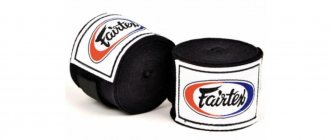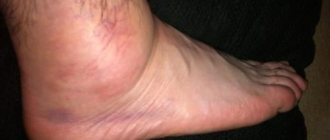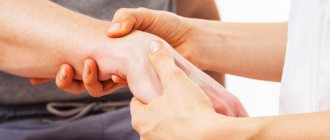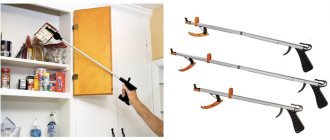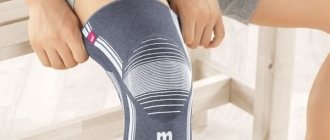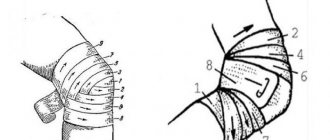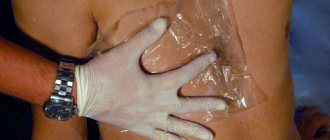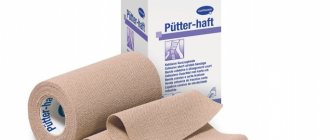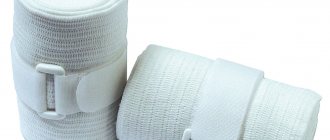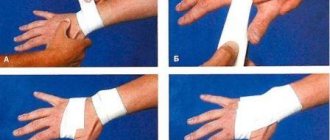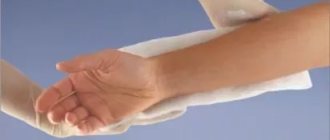Why do you need an elastic bandage for sprains?
The medical bandage is used by athletes not only to treat sprains, but also as a prophylactic against possible injuries.
Advantages of an elastic bandage:
- The ability to firmly fix the damaged area on the body (the bandage does not slip, is not constantly tied or removed);
- reusable;
- resistance to damage;
- Product versatility: the bandage can be used for sprained arms, legs and other ties;
- ease of use: the patient can remove and apply the bandage independently;
- economy;
- when dried, the bandage is pressure-resistant, so it does not cause pain or stretch damaged joints;
- the possibility of complex treatment of sprains and sprains using compresses and ointments.
In order to bandage an injured joint with an elastic bandage, you need to have certain skills and abilities. It is necessary to carefully follow the dressing rules, otherwise improper immobilization of the joint may occur, as well as blood outflow from the damaged area.
Why is compression therapy with an elastic bandage necessary?
The essence of compression therapy is to create distributed pressure on the body. Compression is provided using elastic bandages, compression garments and hardware. The elastic medical bandage "Intex" is a tape made of latex, cotton and polyester fiber. Latex provides the tape with stretch and compression properties, cotton provides softness, and polyester fiber provides strength and durability during washing.
A properly applied elastic bandage applies 100% pressure to the ankle or wrist, decreasing to 70% as it moves toward the hip or shoulder. Distributed pressure eliminates swelling, pain and heaviness in the legs, cramps, reduces trophic ulcers, and prevents thrombosis of superficial and deep veins.
Rules for choosing an elastic bandage
Recently, the domestic market has the largest selection of elastic bandages from various manufacturers. To produce products, manufacturers use only natural anti-allergic materials with varying degrees of flexibility.
The purpose of bandages is related to their length:
- Meter bandage - for immobilization of the wrist joint;
- product up to two meters - ankle orthosis
- two and a half meters - fastening large joints;
- three and a half meters - ligaments of the hand;
- from five meters - knees and other ligaments of the lower extremities.
To ensure good stabilization of damaged joints and ligaments, the product must have good elastic properties: medium to high elongation. The versatile pieces are 100% stretchable and easy to stretch.
Apart from cotton products, adhesive plasters are also available. If the product does not have an adhesive layer, it is applied to the injured knee using special holders for bandages.
The adhesive bandage is intended only to hold the injured area in place for the first stage of treatment, after which it should be replaced with an elastic cotton bandage.
Using the products described above, you can bandage your leg not only for injuries, but also for varicose veins.
How to distinguish a sprain from other joint injuries
Although the principles of emergency care for various types of sprains are the same as for other types of injuries, it is advisable to assess the severity of the injuries before visiting a traumatologist. This will allow you to take additional measures and choose the right tactics that will help avoid complications.
The easiest type of injury is a bruise. It is accompanied by rupture of blood vessels and the formation of hematomas, but the structures of the joint, bones and ligaments remain intact. Its symptoms are pain after injury, which soon decreases and is felt only when pressing on the injured area. The bruise is usually accompanied by swelling, but the range of motion of the injured limb does not decrease.
Dislocation occurs due to displacement of the articular surfaces relative to each other. It can be recognized by the unnatural position of the bone, changes in the shape of the joint, as well as sharp pain when trying to move. The victim should be given first aid for dislocations and sprains, trying not to disturb the deformed joint. Its reduction should only be done by a traumatologist, who must be contacted within the first 24 hours after the injury.
A fracture is usually characterized by sharp pain with movement, numbness at rest, and swelling in the injured area. When pressing on the injured area, acute pain is felt. The victim urgently needs to apply splints, as well as take other emergency measures used for sprains and dislocations, and then be taken to a medical facility.
Sprain and rupture of ligaments can be suspected by the direction of action of the traumatic load. For example, if during a fall your foot twisted sharply or your knee turned inward or outward, then with a high degree of probability a sprain can be assumed. Symptoms are aching pain at rest and sharp pain when moving, which only intensifies over time, and swelling may occur.
A sprain can be distinguished from a fracture by the absence of pain when pressing on the joint. Ligament rupture can be no less dangerous than a fracture. If there is severe pain and immobility, the injured person needs to call an ambulance, and if the condition is not very serious, then within one to two days after the injury you need to see a traumatologist. First aid for a sprained ligament should be provided immediately.
How to use an elastic bandage correctly
When using an elastic bandage as a bandage, you must adhere to the following rules:
- The bandage should be applied from top to bottom (for example, from the ankle to the knee).
- The elastic bandage should be evenly stretched to prevent wrinkles from forming.
- It is best to apply bandages in the morning, when the swelling of the limbs is least. If the procedure cannot be performed in the morning, lie down for 15 minutes and raise your legs. After a short rest, you can begin the procedure.
- The dressing process should be performed by rolling the bandage outward, while avoiding pressure on the soft tissue.
- Each subsequent revolution of the product overlaps the previous one by 1/3. It is unacceptable for there to be a gap between turns of the dressing.
- The maximum tension of the bandage is applied to the lower part of the bandaged joint, then the tension should be gradually loosened.
- It is recommended to start and end the bandage at a distance of fifteen to twenty centimeters from the site of the bruise.
If the wrist joint is torn or sprained, the bandage should be applied from the fingers to the middle of the forearm. In case of an elbow injury, the arm is bandaged from the middle of the forearm to the middle of the shoulder.
The ankle joint is bandaged from the toes to the middle of the shin. For knee injuries, the bandage is performed from the middle of the shin to the middle of the thigh.
Important: an elastic bandage can be used to bandage damaged ligaments and joints. only during active movement, and the product should be removed before going to bed. If the bandage is done correctly, the fingers should first turn blue, but with active movements they will quickly return to normal. When ligating an elbow or knee, do not put pressure on the blood vessels, as this may interfere with blood circulation in the limb.
If after dressing the patient feels numbness or pulsation in the area under the bandage, immediately remove the bandage and apply a gentle rubbing massage.
What is a sprain
Ligaments are bands of connective tissue that surround and strengthen a joint.
Their ends are attached to the mating bones. Thanks to ligaments, the joint can only bend in a certain direction. Any external force aimed at bending a joint in an unnatural direction can lead to spraining, the first signs and first aid for which will be discussed below. The connective tissue that secures the articulation of bones is highly durable and lacks elasticity. She is unable to stretch. When a tensile load is applied, fibers rupture, which, depending on the severity of the injury, can range from a small part to a complete rupture of the ligament. Therefore, in traumatology there is no concept of “sprain”; instead, the term “rupture” is used.
When an injury occurs, along with the rupture of connective tissue fibers, blood vessels usually rupture, which leads to internal hemorrhages with the formation of hematomas and the appearance of swelling.
Let's consider all aspects regarding the definition, causes, types, symptoms of sprains and first aid for this condition.
How long to wear an elastic bandage
Many patients wonder how long they can wear an elastic bandage. The answer depends on the type of injury and the individual patient. The average period of wearing an elastic bandage is about 14 days, but the final decision is made by a traumatologist.
How long can I wear the bandage? The duration of wearing the bandage during one day depends on the patient's activity. If the patient leads an active lifestyle for more than twelve hours a day, the bandage should be changed, otherwise undesirable consequences may occur in the form of circulatory disorders.
The length of time you wear an elastic bandage after surgery depends on many factors. Only the attending physician can give precise recommendations.
Disadvantages of elastic bandages
Many trauma surgeons complain of peeling and itching of the skin under the bandage. The elastic thread contained in the material of the product causes a feeling of discomfort. To avoid discomfort, it is recommended to place a layer of traditional cotton bandage under the bandage (it can be replaced with a regular stocking).
To eliminate signs of hyperkeratosis, you can use any fatty cream suitable for the patient's skin type.
The main disadvantages of elastic bandages:
- involvement of medical personnel in the dressing process;
- Dressing requires special skills that not all patients possess;
- the temperature and water balance of the skin is disturbed when wearing bandages for a long time and on very hot days;
- the need to wear larger clothes and shoes.
Elastic bandage: product care
One of the benefits of elastic bandages is that they can be used over and over again. Bandages can be washed by hand every 3-4 days, but do not use synthetic powders or wring them out. It is recommended to dry the bandage on a smooth surface. It is prohibited to iron the product.
If the operating rules specified above are violated, the bandage will not only lose its functionality, but may also harm the patient’s health.
In conclusion, we would like to note once again that using an elastic bandage on dislocated joints is an effective way to speed up the recovery process, since this product provides reliable immobilization of the injured area for a long time.
Bandages are available in a variety of options and the choice should depend on the stretchability and length of the product. It is recommended to wash the bandage by hand without using synthetic powders, do not wring it out or dry it on a flat surface.
Preparing for treatment
For bandaging
Low stretch bandages. Low-stretch wrap options range from the ultra-simple (short 100% cotton stretch wraps) to the more complex with a nylon/lycra blend in the outer layer and a foam inner layer that has multi-directional elasticity and adjustable compression that "doesn't migrate." Modern bandages have reusable Velcro and/or self-adhesive properties that help keep the bandages in place with little slippage. Most fabrics are cool, comfortable and breathable, hypoallergenic, hard-wearing and durable. Lotion to moisturize the skin and maintain its health. Well-moisturized skin prevents small cracks from forming and prevents bacteria from entering and causing infection. It can also prevent skin irritation from unaccustomed use of bandages. Tubular stocking. Additionally protects the skin and provides a comfortable, breathable base for wrapping. Felt cotton fabric, foam rubber, or foam sheets to add a layer of padding that evenly distributes the compression of the outer wraps.
Compression jersey
Compression clothing is selected by the attending physician. Important factors to consider are:
- compression class,
- appearance,
- material,
- finished product or to order,
- design,
- skin condition.
Elastic compression is recommended to maintain the results achieved by decongestant therapy. In the case of compression hosiery, compression is the force exerted by the product to compress the limbs and promote blood and lymph circulation. Compression is measured at specified points and expressed in millimeters of mercury. The highest value is at the ankle, called point B in medical parlance. The compression gradients indicated on the packages are measured at point B. Medical compression stockings are available in different compression grades:
- Class I: 20-30 mmHg.
- Class II: 30-40 mmHg.
- Class III: 40-50 mmHg.
- Class IV: 50-60 mmHg.
The gradient gradually decreases from point B to the edge of the garment. Sleeves are generally class I or II, gloves and mittens class I, stockings class II or III. Fibers used in elastic compression garments are typically latex or synthetic rubber, nylon, polyester, cotton, or a blend of these. Fabrics can be thick or thin, depending on the fibers used and the compression class (the higher the class, the thicker the garment). Most garments containing latex are knitted from a thread consisting of a latex core wrapped in nylon or cotton, this is important for those with latex allergies. There are three types of knitwear: round knitted, flat knitted and embroidered. Round knit fabrics are seamless but tend to bunch at the top. This creates a tourniquet effect, impeding the flow of fluid from the limb. Flat knits are often made from a rough, textured fabric that can provide a mini-massage to the skin, helping to improve fluid absorption and transport. Sewn, consist of several layers. In order for the clothes to stick better to the body, use a silicone tape inside the upper edge or several longitudinal (not circular) strips of transparent glue.
